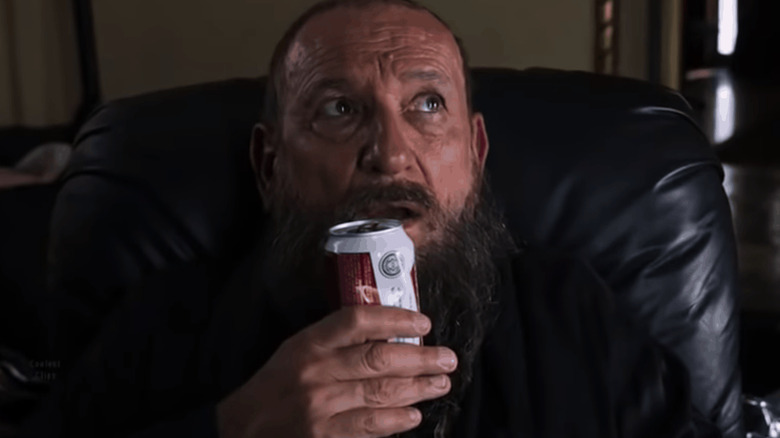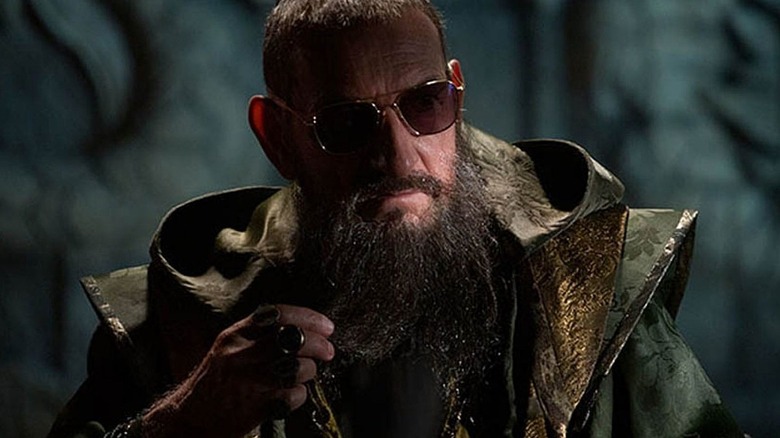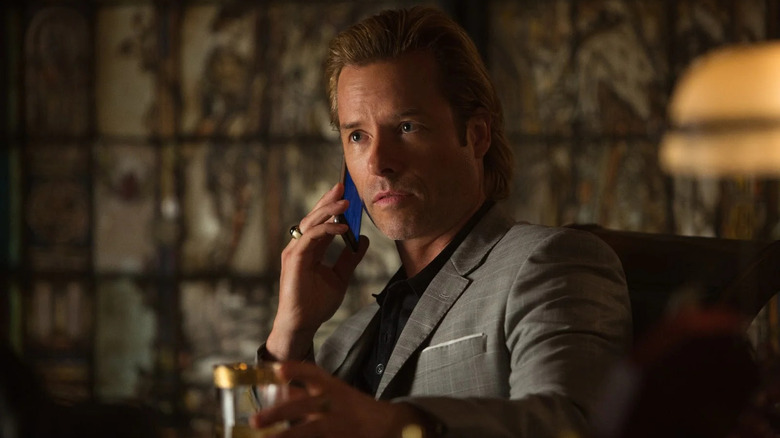Iron Man 3's Mandarin Utterly Terrified Marvel Studios' Execs
Shane Black's 2013 film "Iron Man 3" (or "Iron Man Three" as it is titled on-screen) is handily one of the best films in the long-running and now-pretty-much-dead Marvel Cinematic Universe. It is a clever, witty film that forces Tony Stark (Robert Downey, Jr.) to solve a mystery and face off against bad guys without a fully functioning Iron Man suit. It displayed how capable Stark was as a wise human being as opposed to a mere superhuman. The end of the trilogy also brought the "Iron Man" story to an effective conclusion. We'll simply have to ignore that Iron Man appeared in other films after it.
Additionally, Black invented a clever twist with the film's villain. In the original Iron Man comics, the hero frequently faced off against a nemesis called the Mandarin, a racist Fu-Manchu-like caricature — armed with ten magical rings — born of pulp cliches of the 1960s. "Iron Man 3" initially envisioned the Mandarin (Ben Kingsley) as a threatening terrorist, clearly inspired by Osama bin Laden. While this was a fun way to make the character topical, and to free him of his unfortunate origins, Black figured he'd undo the character even more impishly. It was eventually revealed that the Mandarin seen on TV was a drug-addicted actor named Trevor Slattery, only hired to play the Mandarin as an act of subterfuge.
When making "Iron Man 3," the filmmakers were concerned about the Mandarin. Jon Favreau, the director of 2008's "Iron Man" noted that the magical rings didn't mesh with the science-based superhero, while Black openly acknowledged the character's racist origins. How would this character play to a Chinese audience?
In the book "MCU: The Reign of Marvel Studios" by Joanna Robinson, Dave Gonzalez, and Gavin Edwards, the filmmakers went on record with their Mandarin trepidation.
'You've got to do the Mandarin'
Early in the production of "Iron Man 3," when "Iron Man 2" was still being made, it seems, Favreau was announced as the director, and he declared, "You've got to do the Mandarin." His issue was the character's magical powers, saying, "You don't want to see that. He has 10 magical rings — that just doesn't feel right." He was also said to note the character's similarities to Dr.Fu-Manchu, a character created by a white author in 1912. Even as the character was updated in Marvel comics, the racism remained.
Chris Fenton, an employee of DMG Entertainment (one of the studios backing "Iron Man 3") was quoted as being terrified. How was a film studio in 2013 supposed to sell something with such a toxic past? Fenton said to a Marvel exec that:
"The Mandarin scares the s*** out of us. [...] The Mandarin looks and acts like the stereotypically derogatory Chinese man. Not only does he have a long spiny beard that he's constantly straightening with his fingers, he regularly speaks in uber-'Chinglish,' constantly saying Chinese-cliché types of proverbs."
Yeesh.
According to the "MCU" book, the filmmakers initially wanted the film to have five villains to draw focus away from the Mandarin. It was actor Guy Pearce who, while brainstorming with Black, invented the "terrorist" angle. The Mandarin was not going to be Chinese anymore. Pearce said:
"I pitched the twist with Shane to Kevin two days later. [...] Kevin loved it from the beginning and backed it right the way through."
Kevin as in Kevin Feige, the head honcho at Marvel Studios. Black, it seems, invented the twist that the terrorist Mandarin was a British actor. The name remained, but none of the character's stereotypes did.
Black's plans
Throughout the villain brainstorming process, Shane Black revealed that he felt creatively stymied and had to be a corporate team player. Indeed, his initial vision for the "Iron Man 3" villain was the character of Maya Hansen, the character played by Rebecca Hall. Marvel Studios, however, put the kibosh on the character as a villain ... when they figured her action figures wouldn't earn enough money. Black said:
"We had a female character who was the villain. [...] We had finished the script and we were given a no-holds-barred memo saying 'That cannot stand and we've changed our minds because after consulting, we've decided that the toy won't sell as well if it's a female.' [...] So we had to change the entire script because of toymaking. Now, that's not Feige. That's Marvel corporate."
Black also notoriously shot additional scenes that were intended only to be included in the Chinese release of "Iron Man 3." The cuts in other countries were different.
Note that many of the creative decisions on massive, multi-million-dollar blockbusters like those in the Marvel Cinematic Universe are typically made by studio heads, producers, and moneymen. The actual writers and directors either have to be nimble (like Black), able to adjust to studio demands in a flash, or they have to be inexperienced with productions of that size (probably most of the MCU directors), and willing to kowtow to studio mandates.
In the case of "Iron Man 3," however, brazenly commercial concerns led to some pretty creative solutions and twists that Marvel fans didn't see coming. It would have been nice, however, to have seen Black's story with Maya Hansen as the villain.


